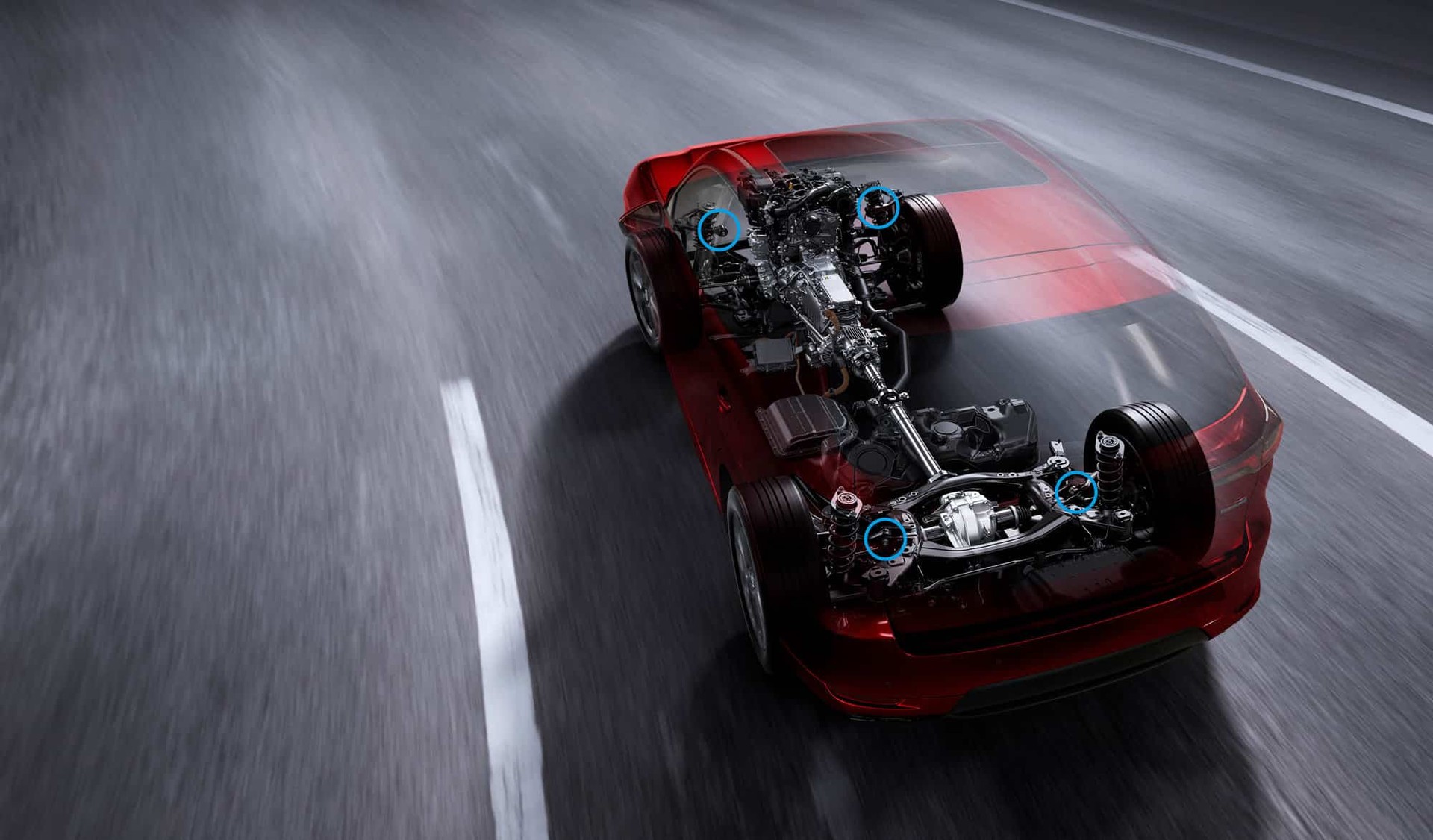
INNOVATE
All Features Great and Small
Based on first impressions, it might seem strange to compare a suspension bushing—each individual piece around 12.5 cm across—with a pair of chopsticks. There is, however, more common ground between the two than you may realize. As Mazda’s Yasuyoshi Mushitani explains, there is far more to suspension bushing than meets the eye.
There are five pairs of chopsticks on the table, arranged in ascending order from the lowest perceived quality to the highest. The first set is from a bento box set, the next from a convenience store, with the third and fourth from upmarket restaurants. The fifth set, remarkably, is a custom-made pair of handmade chopsticks, which have been altered and contoured by one specific user—Shunji Tanaka, the designer of the original Mazda MX‑5. They are made from bamboo and it took Tanaka around 40 years to find the right design. The purpose of the five pairs is to enable Yasuyoshi Mushitani, Senior Principal Engineer at Mazda’s Chassis Dynamics Development Department, to describe the importance of suspension bushing: palm-sized, vitally important parts found in the suspension system of every vehicle.
The chopsticks, Mushitani enthuses, are the ideal representation of how responsive touch, even at the smallest level, can be utilized when driving. They are slim, tapered and lightweight, so that the user instantly knows how much pressure to apply and can receive instant feedback on the food the chopsticks are touching. Even the material used to manufacture the chopsticks, such as bamboo, can change how the food tastes and how the overall meal is perceived. Chopsticks, it’s said, should act as an extension to touch, rather than being a simple device for eating food. It’s these similarities, Mushitani believes, that align with Mazda’s philosophy toward suspension bushing and also help the driver feel more comfortable, in control, and “as one” with their vehicle, whether it’s tackling undulating roads, rough tracks or tight corners.
Bushing is a small, cushioning part of the overall suspension system that’s designed specifically to absorb bumps in the road, to reduce noise under the car, and to control the amount of movement the vehicle chassis experiences during a drive, particularly when cornering. These elements, it would be fair to say, are just as important as any of Mazda’s head-turning exteriors. That each piece of bushing plays such a large role with such a small presence is yet another wonder of engineering.

Each small piece of suspension bushing, with a few examples pictured, is vital for reducing noise, controlling movement, and cornering safely. (Image for illustrative purposes.)
For this, there’s Mushitani to thank. His vision for Mazda’s suspension bushing system was conceived shortly after he first joined Mazda in 1988, with the iconic MX‑5 released one year later, in 1989. Surprisingly, it wasn’t the MX‑5 that sparked Mushitani’s imagination when he eventually joined the Chassis Dynamics Development Department in 1997. Instead, he was assigned to work on the Mazda Titan Dash, a commercial truck that rolled off the production line in 2000. He quickly made a few adjustments to the model, most notably to the suspension bushing, to change the typical toughness of a commercial vehicle to a smoother, more comfortable ride. “I changed just one bushing structure and I got a lot of improvement, not only in the vibration, but with the vehicle motion also,” he explains. “It’s a very small part, but has a big impact on driving.”
Over the past three decades Mazda has developed Mushitani’s brainchild further, proving that suspension bushing has a significant impact on driving experience, even when tweaked and tuned with only 0.1mm differences. It’s all about improving driver comfort, Mushitani explains, as well as playing additional roles in communicating with the driver and “contributing to safety,” he says. While other systems are created to shut out vibration and input reaching the driver, Mazda’s approach is designed to convey road surface conditions. This enables safer decisions to be made on the move, without causing any discomfort to the vehicle’s occupants, and Mazda’s innovative bushing development strikes the sweet spot between informative and non-invasive. Comfortable and safe, it provides a true jinba ittai experience between car and driver.
“We need to determine the geometry and configuration in the bushing, so we depend on the human sense. When it comes to bushing, it’s all about intuition and keeping things simple.”
What’s more surprising is that the process of making bushing isn’t all about machine-made parts. Rather, the human touch, as Mushitani describes, remains vital for ensuring the correct measurements and angles are used in each bushing prototype before manufacture. “We need to determine the geometry and configuration in the bushing, so we depend on the human sense,” he says. “When it comes to bushing, it’s all about intuition and keeping things simple.”
It’s this car-to-driver connection and communication that Mazda continues to champion. When it comes to bushing, it’s a mutually beneficial relationship between the vehicle and its driver. The vehicle, through the suspension, handling and dynamics, communicates with the driver, and the driver can make adjustments and remain in control. “The vehicle shouldn’t become too advanced,” says Mushitani. “Because if the performance of the vehicle is too good, the driver feels ‘driven’ by the vehicle—instead, they need to operate the vehicle themselves. This leads to our philosophy of jinba ittai.” With safety in mind and allowing the driver to experience joy in driving, this small piece of suspension bushing sums up everything there is to know about Mazda.
Words Ed Cooper / Lol Keegan

find out more





